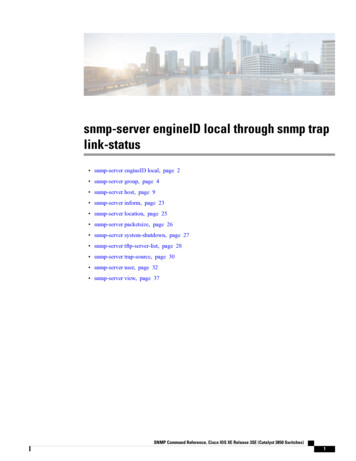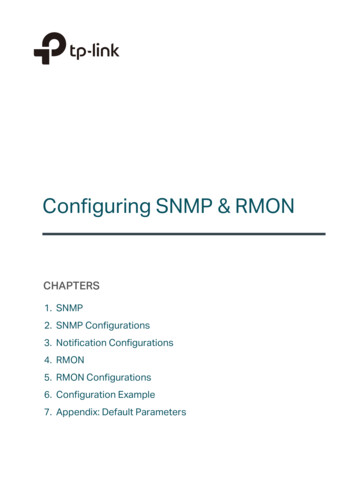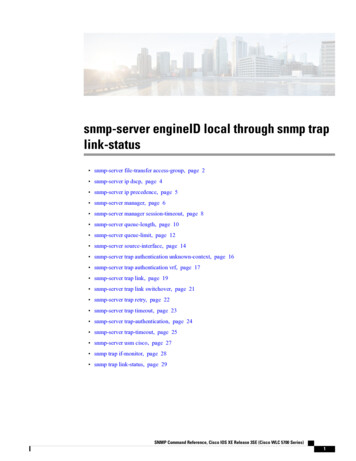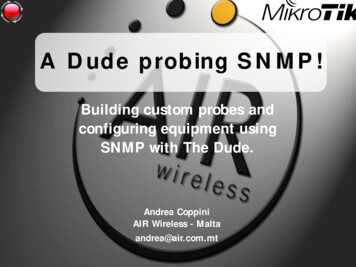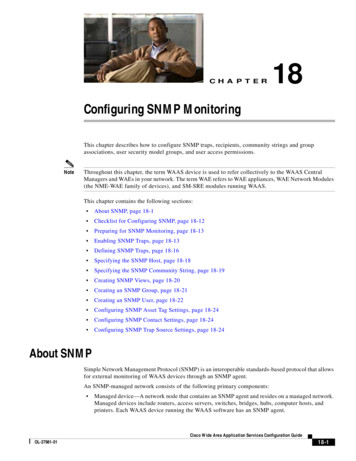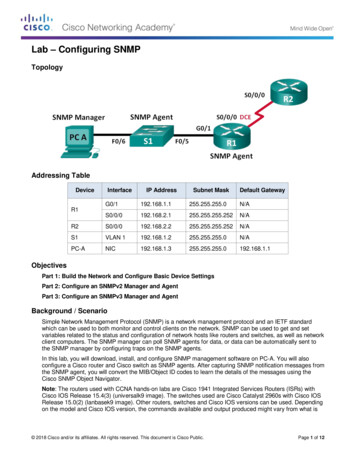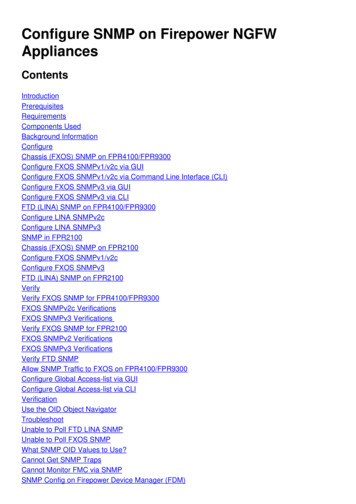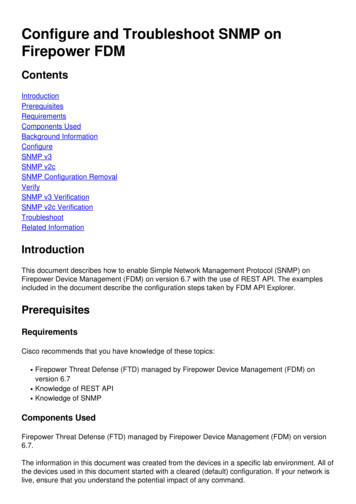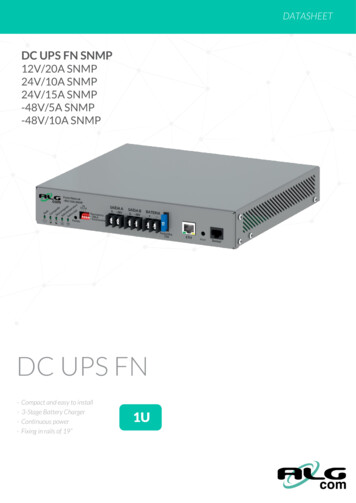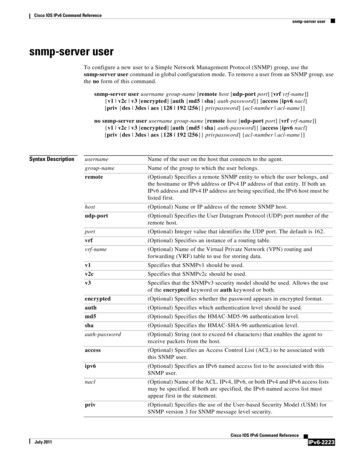
Transcription
Cisco IOS IPv6 Command Referencesnmp-server usersnmp-server userTo configure a new user to a Simple Network Management Protocol (SNMP) group, use thesnmp-server user command in global configuration mode. To remove a user from an SNMP group, usethe no form of this command.snmp-server user username group-name [remote host [udp-port port] [vrf vrf-name]]{v1 v2c v3 [encrypted] [auth {md5 sha} auth-password]} [access [ipv6 nacl][priv {des 3des aes {128 192 256}} privpassword] {acl-number acl-name}]no snmp-server user username group-name [remote host [udp-port port] [vrf vrf-name]]{v1 v2c v3 [encrypted] [auth {md5 sha} auth-password]} [access [ipv6 nacl][priv {des 3des aes {128 192 256}} privpassword] {acl-number acl-name}]Syntax DescriptionusernameName of the user on the host that connects to the agent.group-nameName of the group to which the user belongs.remote(Optional) Specifies a remote SNMP entity to which the user belongs, andthe hostname or IPv6 address or IPv4 IP address of that entity. If both anIPv6 address and IPv4 IP address are being specified, the IPv6 host must belisted first.host(Optional) Name or IP address of the remote SNMP host.udp-port(Optional) Specifies the User Datagram Protocol (UDP) port number of theremote host.port(Optional) Integer value that identifies the UDP port. The default is 162.vrf(Optional) Specifies an instance of a routing table.vrf-name(Optional) Name of the Virtual Private Network (VPN) routing andforwarding (VRF) table to use for storing data.v1Specifies that SNMPv1 should be used.v2cSpecifies that SNMPv2c should be used.v3Specifies that the SNMPv3 security model should be used. Allows the useof the encrypted keyword or auth keyword or both.encrypted(Optional) Specifies whether the password appears in encrypted format.auth(Optional) Specifies which authentication level should be used.md5(Optional) Specifies the HMAC-MD5-96 authentication level.sha(Optional) Specifies the HMAC-SHA-96 authentication level.auth-password(Optional) String (not to exceed 64 characters) that enables the agent toreceive packets from the host.access(Optional) Specifies an Access Control List (ACL) to be associated withthis SNMP user.ipv6(Optional) Specifies an IPv6 named access list to be associated with thisSNMP user.nacl(Optional) Name of the ACL. IPv4, IPv6, or both IPv4 and IPv6 access listsmay be specified. If both are specified, the IPv6 named access list mustappear first in the statement.priv(Optional) Specifies the use of the User-based Security Model (USM) forSNMP version 3 for SNMP message level security.Cisco IOS IPv6 Command ReferenceJuly 2011IPv6-2223
Cisco IOS IPv6 Command Referencesnmp-server userdes(Optional) Specifies the use of the 56-bit Digital Encryption Standard(DES) algorithm for encryption.3des(Optional) Specifies the use of the 168-bit 3DES algorithm for encryption.aes(Optional) Specifies the use of the Advanced Encryption Standard (AES)algorithm for encryption.128(Optional) Specifies the use of a 128-bit AES algorithm for encryption.192(Optional) Specifies the use of a 192-bit AES algorithm for encryption.256(Optional) Specifies the use of a 256-bit AES algorithm for encryption.privpassword(Optional) String (not to exceed 64 characters) that specifies the privacyuser password.acl-number(Optional) Integer in the range from 1 to 99 that specifies a standard accesslist of IP addresses.acl-name(Optional) String (not to exceed 64 characters) that is the name of a standardaccess list of IP addresses.Command DefaultSee Table 327 in the “Usage Guidelines” section for default behaviors for encryption, passwords, andaccess lists.Command ModesGlobal configuration (config)Command HistoryReleaseModification12.0(3)TThis command was introduced.12.3(2)TSupport for named standard access lists was added.12.0(27)SThe ipv6 keyword and nacl argument were added to allow for configurationof IPv6 named access lists and IPv6 remote hosts.12.3(14)TThe ipv6 keyword and nacl argument were integrated into Cisco IOSRelease 12.3(14)T.12.2(33)SRAThis command was integrated into Cisco IOS Release 12.2(33)SRA.12.4(11)TThe priv keyword and associated arguments were added to enable the use ofthe USM for SNMP version 3 for SNMP message level security.12.2(33)SRBThis command was integrated into Cisco IOS Release 12.2(33)SRB.12.2(33)SXHThis command was integrated into Cisco IOS Release 12.2(33)SXH.Cisco IOS XERelease 2.1This command was introduced on Cisco ASR 1000 Series AggregationServices Routers.12.2(33)SBThis command was integrated into Cisco IOS Release 12.2(33)SB.Usage GuidelinesTo configure a remote user, specify the IP address or port number for the remote SNMP agent of thedevice where the user resides. Also, before you configure remote users for a particular agent, configurethe SNMP engine ID, using the snmp-server engineID command with the remote keyword. The remoteagent’s SNMP engine ID is needed when computing the authentication and privacy digests from thepassword. If the remote engine ID is not configured first, the configuration command will fail.Cisco IOS IPv6 Command ReferenceIPv6-2224July 2011
Cisco IOS IPv6 Command Referencesnmp-server userFor the privpassword and auth-password arguments, the minimum length is one character; therecommended length is at least eight characters, and should include both letters and numbers.Table 327 describes the default user characteristics for encryption, passwords, and access lists.Table 327snmp-server user Default DescriptionsCharacteristicDefaultAccess listsAccess from all IP access lists is permitted.EncryptionNot present by default. The encrypted keyword is used tospecify that the passwords are message digest algorithm 5(MD5) digests and not text passwords.PasswordsAssumed to be text strings.Remote usersAll users are assumed to be local to this SNMP engine unlessyou specify they are remote with the remote keyword.SNMP passwords are localized using the SNMP engine ID of the authoritative SNMP engine. Forinforms, the authoritative SNMP agent is the remote agent. You need to configure the remote agent’sSNMP engine ID in the SNMP database before you can send proxy requests or informs to it.NoteChanging the engine ID after configuring the SNMP user, does not allow to remove the user. To removethe user, you need to first reconfigure the SNMP user.Working with Passwords and DigestsNo default values exist for authentication or privacy algorithms when you configure the command. Also,no default passwords exist. The minimum length for a password is one character, although Ciscorecommends using at least eight characters for security. If you forget a password, you cannot recover itand will need to reconfigure the user. You can specify either a plain-text password or a localized MD5digest.If you have the localized MD5 or Secure Hash Algorithm (SHA) digest, you can specify that stringinstead of the plain-text password. The digest should be formatted as aa:bb:cc:dd where aa, bb, and ccare hexadecimal values. Also, the digest should be exactly 16 octets long.ExamplesThe following example shows how to add the user abcd to the SNMP server group named public. In thisexample, no access list is specified for the user, so the standard named access list applied to the groupapplies to the user.Router(config)# snmp-server user abcd public v2cThe following example shows how to add the user abcd to the SNMP server group named public. In thisexample, access rules from the standard named access list qrst apply to the user.Router(config)# snmp-server user abcd public v2c access qrstIn the following example, the plain-text password cisco123 is configured for the user abcd in the SNMPserver group named public:Router(config)# snmp-server user abcd public v3 auth md5 cisco123When you enter a show running-config command, a line for this user will be displayed. To learn if thisuser has been added to the configuration, use the show snmp user command.Cisco IOS IPv6 Command ReferenceJuly 2011IPv6-2225
Cisco IOS IPv6 Command Referencesnmp-server userNoteThe show running-config command does not display any of the active SNMP users created in authPrivor authNoPriv mode, though it does display the users created in noAuthNoPriv mode. To display anyactive SNMPv3 users created in authPriv, authNoPrv, or noAuthNoPriv mode, use the show snmp usercommand.If you have the localized MD5 or SHA digest, you can specify that string instead of the plain-textpassword. The digest should be formatted as aa:bb:cc:dd where aa, bb, and cc are hexadecimal values.Also, the digest should be exactly 16 octets long.In the following example, the MD5 digest string is used instead of the plain-text password:Router(config)# snmp-server user abcd public v3 encrypted auth In the following example, the user abcd is removed from the SNMP server group named public:Router(config)# no snmp-server user abcd public v2cIn the following example, the user abcd from the SNMP server group named public specifies the use ofthe 168-bit 3DES algorithm for privacy encryption with secure3des as the password.Router(config)# snmp-server user abcd public priv v2c 3des secure3desRelated CommandsCommandDescriptionshow running-configDisplays the contents of the currently running configuration file or theconfiguration for a specific interface, or map class information.show snmp userDisplays information on each SNMP username in the group username table.snmp-server engineID Displays the identification of the local SNMP engine and all remote enginesthat have been configured on the router.Cisco IOS IPv6 Command ReferenceIPv6-2226July 2011
Cisco IOS IPv6 Command Referencesnmp trap link-statussnmp trap link-statusTo enable Simple Network Management Protocol (SNMP) link trap generation, use the snmp traplink-status command in either interface configuration mode or service instance configuration mode. Todisable SNMP link traps, use the no form of this command.snmp trap link-status [permit duplicates]no snmp trap link-status [permit duplicates]Syntax Description.permit duplicatesCommand DefaultSNMP link traps are sent when an interface goes up or down.Command ModesInterface configuration (config-if)Service instance configuration (config-if-srv)Command HistoryReleaseUsage Guidelines(Optional) Permits duplicate SNMP linkup and linkdown traps.Modification10.0This command was introduced.12.2(30)SThe permit duplicates keyword pair was added in Cisco IOSRelease 12.2(30)S.12.3(8)TSupport for the permit duplicates keyword pair was integrated in Cisco IOSRelease 12.3(8)T.12.2(33)SRAThis command was integrated into Cisco IOS Release 12.2(33)SRA.12.2SXThis command is supported in the Cisco IOS Release 12.2SX train. Supportin a specific 12.2SX release of this train depends on your feature set,platform, and platform hardware.12.2(33)SBThis command’s behavior was modified on the Cisco 10000 series router forthe PRE3 and PRE4 as described in the Usage Guidelines.12.2(33)SRD1Support for this command was extended to service instance configurationmode in Cisco IOS Release 12.2(33)SRD1.By default, SNMP link traps are sent when an interface goes up or down. For interfaces expected to goup and down during normal usage, such as ISDN interfaces, the output generated by these traps may notbe useful. The no form of this command disables these traps.The permit and duplicates keywords are used together and cannot be used individually. Use the permitduplicates keyword pair when an interface is not generating SNMP linkup traps, linkdown traps, or both.When the snmp trap link-status permit duplicates command is configured, more than one trap may besent for the same linkup or linkdown transition.The permit duplicates keyword pair does not guarantee that SNMP link traps will be generated norshould configuring these keywords be required to receive traps.Cisco IOS IPv6 Command ReferenceJuly 2011IPv6-2227
Cisco IOS IPv6 Command Referencesnmp trap link-statusBy default, in service instance configuration mode SNMP link traps are not sent. Also, the permitduplicates keyword pair is not available in service instance configuration mode.Cisco 10000 Series Router Usage GuidelinesIn Cisco IOS Release 12.2(33)SB, the virtual-template snmp command has a new defaultconfiguration. Instead of being enabled by default, no virtual-template snmp is the defaultconfiguration. This setting enhances scaling and prevents large numbers of entries in the MIB ifTable,thereby avoiding CPU Hog messages as SNMP uses the interfaces MIB and other related MIBs.If you configure the no virtual-template snmp command, the router no longer accepts the snmp traplink-status command under a virtual-template interface. Instead, the router displays a configurationerror message such as the following:Router(config)# interface virtual-template 1Router(config-if)# snmp trap link-status%Unable set link-status enable/disable for interfaceIf your configuration already has the snmp trap link-status command configured under avirtual-template interface and you upgrade to Cisco IOS Release 12.2(33)SB, the configuration erroroccurs when the router reloads even though the virtual template interface is already registered in theinterfaces MIB.ExamplesThe following example shows how to disable SNMP link traps related to the ISDN BRI 0 interface:Router(config)# interface bri 0Router(config-if)# no snmp trap link-statusThe following example shows how to enable SNMP link traps for service instance 50 on Ethernetinterface 0/1:Router(config)# interface ethernet 0/1Router(config-if)# service instance 50 ethernetRouter(config-if-srv)# snmp trap link-statusRouter(config-if-srv)# exitRelated CommandsCommandDescriptionvirtual-template snmp Allows virtual access interfaces to register with SNMP when they are createdor reused.Cisco IOS IPv6 Command ReferenceIPv6-2228July 2011
Cisco IOS IPv6 Command Referencesntp addresssntp addressTo specify the IPv6 Simple Network Time Protocol (SNTP) server address list to be sent to the client,use the sntp address command in DHCP for IPv6 pool configuration mode. To remove the SNTP serveraddress list, use the no form of the command.sntp address ipv6-addressno sntp address ipv6-addressSyntax Descriptionipv6-addressCommand DefaultNo SNTP server address is specified.Command ModesIPv6 DHCP pool configurationCommand HistoryReleaseModification12.4(15)TThis command was introduced.Cisco IOS XERelease 2.5This command was updated. It was integrated into Cisco IOS XERelease 2.5.Usage GuidelinesThe IPv6 SNTP address of a server to be sent to the client.The Dynamic Host Configuration Protocol (DHCP) for IPv6 for stateless configuration allows a DHCPfor IPv6 client to export configuration parameters (that is, DHCP for IPv6 options) to a local DHCP forIPv6 server pool. The local DHCP for IPv6 server can then provide the imported configurationparameters to other DHCP for IPv6 clients.The SNTP server address list option provides a list of one or more IPv6 addresses of SNTP serversavailable to the client for synchronization. The clients use these SNTP servers to synchronize theirsystem time to that of the standard time servers.Clients must treat the list of SNTP servers as an ordered list, and the server may list the SNTP serversin decreasing order of preference. The option defined in this document can be used only to configureinformation about SNTP servers that can be reached using IPv6.The SNTP server option code is 31. For more information on DHCP options and suboptions, see the“DHCP Options” appendix in the Network Registrar User's Guide, Release 6.2.ExamplesThe following example shows how to specify the SNTP server address:sntp address 300::1Related CommandsCommandDescriptionimport sntp addressImports the SNTP server option to a DHCP for IPv6 client.Cisco IOS IPv6 Command ReferenceJuly 2011IPv6-2229
Cisco IOS IPv6 Command Referencespd extended-headroomspd extended-headroomTo configure Selective Packet Discard (SPD) extended headroom, use the spd extended-headroomcommand in global configuration mode. To return to the default value, use the no form of this command.spd extended-headroom sizeno spd extended-headroomSyntax DescriptionsizeCommand DefaultThe SPD extended headroom default is 10 packets.Command ModesGlobal configuration (config)Command HistoryReleaseModification12.2(33)SXHThis command was introduced.12.2(33)SRCThis command was integrated into Cisco IOS Release 12.2(33)SRC.Cisco IOS XERelease 2.6This command was integrated into Cisco IOS XE Release 2.6.15.1(3)TThis command was integrated into Cisco IOS Release 15.1(3)T.Usage GuidelinesExamplesSPD headroom size, in number of packets.Because Interior Gateway Protocols (IGPs) and link stability are tenuous and crucial, such packets aregiven the highest priority and are given extended SPD headroom with a default of 10 packets. Thesepackets are not dropped if the size of the input hold queue is lower than 185 (input queue default size SPD headroom size SPD extended headroom).The following example shows how to configure SPD extended headroom to be 11 packets:Router(config)# spd extended-headroom 11Related CommandsCommandDescriptionshow ipv6 spdDisplays the IPv6 SPD configuration.spd headroomConfigures SPD headroom.Cisco IOS IPv6 Command ReferenceIPv6-2230July 2011
Cisco IOS IPv6 Command Referencespd headroomspd headroomTo configure Selective Packet Discard (SPD) headroom, use the spd headroom command in globalconfiguration mode. To return to the default value, use the no form of this command.spd headroom sizeno spd headroomSyntax DescriptionsizeCommand DefaultThe SPD headroom default is 100 packets.Command ModesGlobal configuration (config)Command HistoryReleaseModification12.2(33)SXHThis command was introduced.12.2(33)SRCThis command was integrated into Cisco IOS Release 12.2(33)SRC.Cisco IOS XERelease 2.6This command was integrated into Cisco IOS XE Release 2.6.15.1(3)TThis command was integrated into Cisco IOS Release 15.1(3)T.Usage GuidelinesExamplesSPD headroom size, in number of packets.SPD prioritizes IPv6 packets with a precedence of 7 by allowing the software to queue them into theprocess level input queue above the normal input queue limit. The number of packets allowed in excessof the normal limit is called the SPD headroom, the default being 100, which means that a highprecedence packet is not dropped if the size of the input hold queue is lower than 175 (input queuedefault size SPD headroom size).The following example shows how to configure SPD headroom to be 95 packets:Router(config)# spd headroom 95Related CommandsCommandDescriptionshow ipv6 spdDisplays the IPv6 SPD configuration.spdextended-headroomConfigures SPD extended headroom.Cisco IOS IPv6 Command ReferenceJuly 2011IPv6-2231
Cisco IOS IPv6 Command Referencespf-interval (IPv6)spf-interval (IPv6)To configure how often Cisco IOS software performs the shortest path first (SPF) calculation, use thespf-interval command in address family configuration mode. To restore the default interval, use the noform of this command.spf-interval [level-1 level-2] seconds [initial-wait] [secondary-wait]no spf-interval secondsSyntax Descriptionlevel-1(Optional) Summarizes only routes redistributed into Level 1 with theconfigured prefix value.level-2(Optional) Summarizes routes learned by Level 1 routing into the Level 2backbone with the configured prefix value. Redistributed routes into Level 2IS-IS also are summarized.secondsMinimum amount of time between SPF calculations, in seconds. It can be anumber from 1 to 120. The default is 5 seconds.initial-wait(Optional) Length of time before the first SPF calculation in milliseconds.secondary-wait(Optional) Minimum length of time between the first and second SPFcalculation, in milliseconds.Command DefaultThe default is 5 seconds.Command ModesAddress family configurationCommand HistoryReleaseModification12.2(15)TThis command was introduced.12.2(18)SThis command was integrated into Cisco IOS Release 12.2(18)S.12.0(26)SThis command was integrated into Cisco IOS Release 12.0(26)S.12.2(28)SBThis command was integrated into Cisco IOS Release 12.2(28)SB.12.2(25)SGThis command was integrated into Cisco IOS Release 12.2(25)SG.12.2(33)SRAThis command was integrated into Cisco IOS Release 12.2(33)SRA.12.2(33)SXHThis command was integrated into Cisco IOS Release 12.2(33)SXH.Cisco IOS XERelease 2.6This command was introduced on Cisco ASR 1000 Series Routers.Usage GuidelinesSPF calculations are performed only when the topology changes. They are not performed when externalroutes change.Cisco IOS IPv6 Command ReferenceIPv6-2232July 2011
Cisco IOS IPv6 Command Referencespf-interval (IPv6)The spf-interval (IPv6) command controls how often Cisco IOS software can perform the SPFcalculation. The SPF calculation is processor-intensive. Therefore, it may be useful to limit how oftenthe SPF calculation is performed, especially when the area is large and the topology changes often.Increasing the SPF interval reduces the processor load of the router, but it could slow down the rate ofconvergence.If IPv6 and IPv4 are configured on the same interface, they must be running the same IntermediateSystem-to-Intermediate System (IS-IS) level.You can use the spf-interval (IPv6) command only when using the IS-IS multitopology support for IPv6feature.ExamplesThe following example sets the SPF calculation interval to 30 seconds:Router(config)# router isisRouter(config-router)# address-family ipv6Router(config-router-af)# spf-interval 30Related CommandsCommandDescriptionprc-interval (IPv6)Controls the hold-down period between PRCs.Cisco IOS IPv6 Command ReferenceJuly 2011IPv6-2233
Cisco IOS IPv6 Command Referencesplit-horizon (IPv6 RIP)split-horizon (IPv6 RIP)To configure split horizon processing of IPv6 Routing Information Protocol (RIP) router updates, usethe split-horizon command in router configuration mode. To disable the split horizon processing of IPv6RIP updates, use the no form of this command.split-horizonno split-horizonSyntax DescriptionThis command has no arguments or keywords.Command DefaultSplit horizon is configured and active by default. However, for ATM interfaces and subinterfacessplit-horizon is disabled by default.Command ModesRouter configurationCommand HistoryReleaseModification12.2(2)TThis command was introduced.12.0(21)STThis command was integrated into Cisco IOS Release 12.0(21)ST.Usage Guidelines12.0(22)SThis command was integrated into Cisco IOS Release 12.0(22)S.12.2(14)SThis command was integrated into Cisco IOS Release 12.2(14)S.12.2(28)SBThis command was integrated into Cisco IOS Release 12.2(28)SB.12.2(25)SGThis command was integrated into Cisco IOS Release 12.2(25)SG.12.2(33)SRAThis command was integrated into Cisco IOS Release 12.2(33)SRA.12.2(33)SXHThis command was integrated into Cisco IOS Release 12.2(33)SXH.The split-horizon (IPv6 RIP) command is similar to the ip split-horizon command, except that it isIPv6-specific.This command configures split horizon processing of IPv6 RIP router updates. When split horizon isconfigured, the advertisement of networks out the interfaces from which the networks are learned issuppressed.If both split horizon and poison reverse are configured, then split horizon behavior is replaced by poisonreverse behavior (routes learned via RIP are advertised out the interface over which they were learned,but with an unreachable metric).NoteIn general, changing the state of the default for the split-horizon command is not recommended, unlessyou are certain that your application requires a change in order to properly advertise routes. If splithorizon is disabled on a serial interface (and that interface is attached to a packet-switched network), youmust disable split horizon for all routers and access servers in any relevant multicast groups on thatnetwork.Cisco IOS IPv6 Command ReferenceIPv6-2234July 2011
Cisco IOS IPv6 Command Referencesplit-horizon (IPv6 RIP)ExamplesThe following example configures split horizon processing for the IPv6 RIP routing process namedcisco:Router(config)# ipv6 router rip ciscoRouter(config-rtr)# split-horizonRelated CommandsCommandDescriptionneighbor (RIP)Defines a neighboring router with which to exchange routing information.Cisco IOS IPv6 Command ReferenceJuly 2011IPv6-2235
Cisco IOS IPv6 Command ReferencesshsshTo start an encrypted session with a remote networking device, use the ssh command in privileged EXECor user EXEC mode.ssh [-v {1 2}] [-c {3des aes128-cbc aes192-cbc aes256-cbc}] [-l userid -l userid:vrfnamenumber ip-address -l userid:rotarynumber ip-address] [-m {hmac-md5 hmac-md5-96 hmac-sha1 hmac-sha1-96}] [-o numberofpasswordprompts n] [-p port-num] {ip-addr hostname} [command] [-vrf]Syntax Description-v-c {3des aes128-cbc aes192-cbc aes256-cbc}-l userid(Optional) Specifies the version of Secure Shell (SSH) to use toconnect to the server. 1—Connects using SSH Version 1. 2—Connects using SSH Version 2.(Optional) Specifies the crypto algorithms Data EncryptionStandard (DES), Triple DES (3DES), or Advanced EncryptionStandard (AES) to use for encrypting data. AES algorithmssupported are aes128-cbc, aes192-cbc, and aes256-cbc. To use SSH Version 1, you must have an encryption imagerunning on the router. Cisco software images that includeencryption have the designators “k8” (DES) or “k9” (3DES). SSH Version 2 supports only the following crypto algorithms:aes128-cbc, aes192-cbc, aes256-cbc, and 3des-cbc. SSHVersion 2 is supported only in 3DES images. If you do not specify the -c keyword, during negotiation theremote networking device sends all the supported cryptoalgorithms. If you configure the -c keyword and the server does notsupport the argument that you have shown (des, 3des,aes128-cbc, aes192-cbc, or aes256-cbc), the remotenetworking device closes the connection.(Optional) Specifies the user ID to use when logging in on theremote networking device running the SSH server. If no user ID isspecified, the default is the current user ID.Cisco IOS IPv6 Command ReferenceIPv6-2236July 2011
Cisco IOS IPv6 Command Referencessh-l userid:vrfname numberip-address(Optional) Specifies the user ID when configuring reverse SSH byincluding port information in the userid field. :—Signifies that a port number and terminal IP address willfollow the user ID. vrfname — User specific VRF. number—Terminal or auxiliary line number. ip-address—IP address of the terminal server.Note-l userid:rotarynumberip-addressThe userid argument and :number ip-address delimiterand arguments must be used if you are configuring reverseSSH by including port information in the userid field (amethod that is easier than the longer method of listingeach terminal or auxiliary line on a separate commandconfiguration line).The vrfname allows SSH to establishsessions with hosts whose addresses are in a VRFinstance.(Optional) Specifies that the terminal lines are to be groupedunder the rotary group for reverse SSH. :—Signifies that a rotary group number and terminal IPaddress will follow. number—Terminal or auxiliary line number. ip-address—IP address of the terminal server.NoteThe userid argument and :rotary{number} {ip-address}delimiter and arguments must be used if you areconfiguring reverse SSH by including rotary informationin the userid field (a process that is easier than the longerprocess of listing each terminal or auxiliary line on aseparate command configuration line).-m {hmac-md5 hmac-md5-96 (Optional) Specifies a Hashed Message Authentication Codehmac-sha1 hmac-sha1-96}(HMAC) algorithm. SSH Version 1 does not support HMACs. If you do not specify the -m keyword, the remote device sendsall the supported HMAC algorithms during negotiation. If youspecify the -m keyword and the server does not support theargument that you have shown (hmac-md5, hmac-md5-96,hmac-sha1, and hmac-sha1-96), the remote device closes theconnection.-o numberofpasswordprompts n (Optional) Specifies the number of password prompts that thesoftware generates before ending the session. The SSH server mayalso apply a limit to the number of attempts. If the limit set by theserver is less than the value specified by the-o numberofpasswordprompts keyword, the limit set by theserver takes precedence. The default is 3 attempts, which is alsothe Cisco IOS SSH server default. The range of values is from 1to 5.-p port-num(Optional) Indicates the desired port number for the remote host.The default port number is 22.Cisco IOS IPv6 Command ReferenceJuly 2011IPv6-2237
Cisco IOS IPv6 Command Referencesship-addr hostnameSpecifies the IPv4 or IPv6 address or host name of the remotenetworking device.command(Optional) Specifies the Cisco IOS command that you want to runon the remote networking device. If the remote host is not runningCisco IOS software, this may be any command recognized by theremote host. If the command includes spaces, you must enclosethe command in quotation marks.-vrf(Optional) Adds VRF awareness to SSH client side functionality.VRF instance name in the client is provided with the IP address tolookup the correct routing table and establish a connection.Command DefaultNo encrypted session exists if the command is not used.Command ModesUser EXEC ( )Privileged EXEC (#)Command HistoryReleaseModification12.1(3)TThis command was introduced.12.2(8)TSupport for IPv6 addresses was added.12.0(21)STIPv6 address support was integrated into Cisco IOS Release 12.0(21)ST.12.0(22)SIPv6 address support was integrated into Cisco IOS Release 12.0(22)S.12.2(14)SIPv6 address support was integrated into Cisco IOS Release 12.2(14)S.12.2(17a)SXThis command was integrated into Cisco IOS Release 12.2(17a)SX.12.3(7)TThis command was expanded to include Secure Shell Version 2 support. The-c keyword was expanded to include support for the following crypticalgorithms: aes128-cbc, aes192-cbc, and aes256-cbc. The -m keyword wasadded, with the following
snmp trap link-status IPv6-2227 Cisco IOS IPv6 Command Reference July 2011 snmp trap link-status To enable Simple Network Management Protocol (SNMP) link trap generation, use the snmp trap link-status command in either interface configuration mode or service instance configuration mode. To disable SNMP link traps, use the no form of this command.
